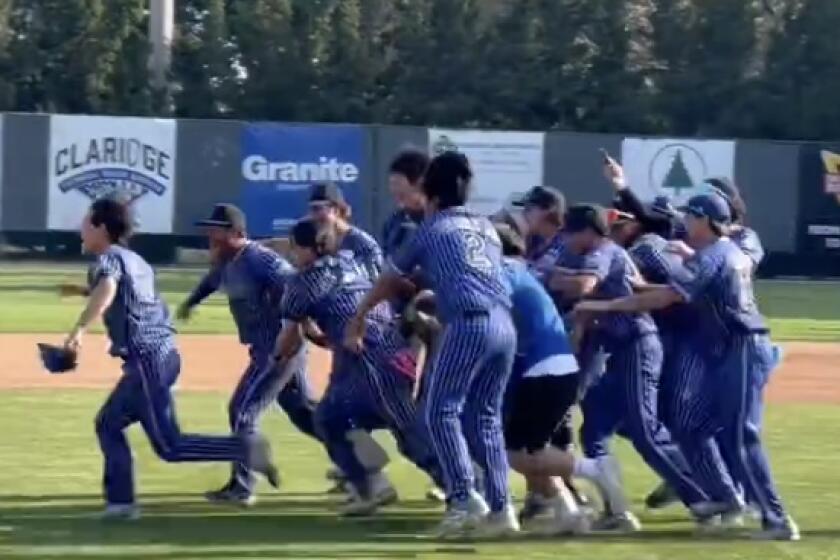Refusing to Knuckle Under : 33-Year-Old Secrist Pursues a Big League Dream on Strength of His Floater
The face is slightly weathered and a tad rounder because of age, but with his blond hair, mustache, aqua-colored eyes and a small cleft in his chin, it is not difficult to believe that Jon Secrist once found part-time work as a Robert Redford look-alike.
Contracted by a Hollywood production company and outfitted almost always as the Sundance Kid, Secrist spent 1978 frequenting parties where he shot grins at guests and mugged for photographs before hopping into a limousine and riding off into the sunset with his appearance fee.
For Secrist, it was enjoyable work even if he was, in essence, simply an illusion.
Ten years later, most would claim that the 33-year old Secrist is still living a fantasy life. A one-time politician, part-time actor and self-taught, full-time knuckleball pitcher, Secrist is adamantly pursuing his dream of becoming a major league baseball player.
“Of any place on this planet where you can achieve your dreams and live them, it’s America,” said Secrist, who lives in Westlake Village and ran for the state Assembly when he was 21. “I’m going for the brass ring, I admit it. But I really do believe that if you let your dreams die, a part of you dies, too.”
Unlike Redford’s larger-than-life portrayal of Roy Hobbs, Secrist is anything but a natural. He was cut from the Monroe High freshman baseball team and never played organized ball in high school or college. But a children’s television show, a tutoring session in a hotel lobby with Phil Niekro, a baseball-playing trip to the Netherlands and hundreds of innings pitched for Valley-area semipro teams have all contributed to Secrist’s dream.
Three attempts at open professional tryouts in the past two years have proved unsuccessful. Secrist, however, is gearing up for an invitational tryout in about two weeks with the Fresno Suns, an independent team in the Class-A California League.
Secrist may have an earned-run average of 5.49 and a 2-2 record this summer, but he speaks effusively when he discusses his goals. Given the opportunity to play in a professional environment, he thinks he can become as effective as the handful of major league pitchers who have made the knuckler their trademark.
Knuckleballers Hoyt Wilhelm, Wilbur Wood and Phil and Joe Niekro enjoyed lengthy careers and Charlie Hough of the Texas Rangers and Tom Candiotti of the Cleveland Indians continue to baffle batters.
At first glance, Secrist is similar to those aforementioned pitchers in that he has a simple and unhurried windup characteristic of successful knucklers. With his cap pulled down along his brow, the 5-foot, 11-inch, 175-pound right-hander passes for a player in his mid-to-late 20s. He throws knuckleballs 90% of the time and works quickly when batters are beating his pitches into the ground. When he is in trouble spectators can hear him chattering encouragement to himself.
Most pitchers who have made their living with the knuckler, however, have added the pitch to their repertoire after finding themselves in the major leagues without a major league fastball. Even Jim Bouton, one of the most unpopular players in baseball circles after publication of his book “Ball Four,” was able to launch a short knuckleballing comeback with the Atlanta Braves because of his earlier success as a hard-throwing right-hander for the New York Yankees.
“It’s not very easy coming off the street,” one scout said. “In professional baseball, when you’re on the outside looking in, it’s utterly impossible.”
Secrist said he recognizes the obstacles he’s up against. He looks a questioner squarely in the eye and often punctuates statements by slamming his fist down onto the nearest piece of furniture. Secrist’s expression becomes stern when he addresses those who mistake a would-be knuckleballer for a knucklehead.
“I’ve been called a bum, a loser, a guy living a pipe dream and somebody who’s never going to grow up,” said Secrist, who owns a small mail-order auto parts business. “But just because I haven’t made it at 33, does that mean I’m not going to make it at all? James Michener was 39 when he wrote his first book. There are countless other stories like that.
“I don’t care if it’s this year or ten years from now. I’m going to make it.”
Leave it to scouts, whose livelihood demands skepticism, to damper a dream.
Most scouts in the Valley area have seen Secrist pitch either for the Conejo Cubs--a semipro team for which he plays during the summer--or his self-sponsored Valley Pros team that is composed of local professional ballplayers who play college teams during the fall.
“On occasion, he’ll show you an average major league knuckleball,” one scout said. “but it’s very, very occasional and he’s throwing against doctors, lawyers and Indian chiefs. I wish him the very best, but I think he’d be better off pursuing another career.
“If he makes it to the big leagues, I’m coming back myself.”
A couple of players with major league experience, however, think Secrist could flutter his way into a major league ballpark.
Rene Gonzales, a utility infielder who plays in the major leagues with the Baltimore Orioles and has batted against most of the modern-day knucklers, played with Secrist on the Valley Pros last fall.
“Jon was getting people out consistently in all the games that I was out there,” Gonzales said. “Does he have a professional-quality knuckleball? I’m going to have to say, yeah, he does.”
Phil Lombardi, a former Kennedy High catcher who is in triple A with the New York Mets organization, caught both Niekros when he was with the New York Yankees. Lombardi played third base for the Valley Pros last fall when Secrist struck out 16 batters in seven innings against a semipro team from Palm Springs.
“Jon throws a soft knuckleball like Phil Niekro,” Lombardi said. “He’s pitched against some legitimate college teams and he makes some of those guys look pretty bad. He’s not really facing professional hitters, but it would be interesting for someone to give him a chance. Put him in A ball and see what he can do. Put him under the fire. He deserves a shot.”
Scouts who doubt Secrist’s ability say they are impressed by his determination and dedication, but the same characteristics sometimes puzzle his mother, Ruth, who jokingly describes her only son’s passion by lamenting: “And they said the teen-age years would be bad.”
As a child, Secrist was scrawny and he drove his parents crazy by incessantly throwing a baseball against the front steps of the family’s Van Nuys home and making long-distance phone calls to companies that sold nutritional supplements for gaining weight.
Being cut as a second baseman from Monroe “was a big turning point in my life,” said Secrist, who began channeling his energies into high-performance cars. After graduation from high school in 1973, Secrist drove around the country for 12 weeks before returning home to work for General Motors.
In 1974, he enrolled at Pierce College. Two years later, while still a student at Pierce, he ran for the Democratic nomination in the 39th Assembly District.
“I was always one of those kids that would knock on doors for people and hand out stuff during elections,” Secrist said. “I thought that if I was a state assemblyman at 21, by the time I was 30 or 31, I could be a U. S senator.”
Running a campaign out of his bedroom with the slogan, “Out of the Political Darkness Comes a New Light,” Secrist garnered 5,028 votes in the 1976 June primary. His opponent, Jim Keysor, received 28,380. Mr. Secrist wasn’t going to Sacramento or Washington, so he opted for Hollywood instead.
“That campaign was a great education,” Secrist said. “It taught me I didn’t want to be in politics because you have to say things you really don’t believe and be nice to people you don’t like.
“You have to be an actor. When the election was over, I said, ‘This is ridiculous, I want to be an actor.’ ”
So he became one. Sort of.
The look-a-like stint helped Secrist land a few commercials, but he gave up the job after a year so he could establish his own identity. He took classes at Cal State Northridge, attended acting school and worked infrequently while doing other occasional acting jobs.
But Secrist, a lifelong baseball fan who said he was hooked as a child the minute he caught a glimpse at a neighborhood minor leaguer’s Cleveland Indians uniform, was still searching for a way to break into the game.
Five years ago, Secrist joined a local semipro team and tried to survive as a junk-ball pitcher. After one of his many shellings, he went home, flicked on the television and saw Hough floating pitches past hitters. “It clicked right there,” Secrist said, “that this is what I had to do.”
Secrist experimented with a variety of knuckleball grips, all of which incorrectly involved his knuckles rather than his fingertips, and produced pitches that rotated rather than floated and dipped. Secrist calls it fate that he woke up early on a Saturday morning and tuned his television to a children’s program called “The Baseball Bunch.” Charlie Hough, the featured guest, explained and demonstrated the way he threw his knuckleball.
The date was July 20, 1984, and Secrist remembers it as the first day he threw a knuckleball without rotation. In August of that year, Secrist learned more lessons by driving to the Orange County hotel where the New York Yankees were staying and cornering Phil Niekro in the lobby as the players got off the team bus.
“I said, ‘Hey, I drove 90 miles to talk to you. This is the only coaching I’ve ever had in my life,’ ” Secrist said. “He told me two very important things; to concentrate on an early release and keeping my wrist stiff. It’s the biggest help I’ve ever had.”
In the spring of ‘85, Secrist’s improving knuckleball earned him a trip to compete in a league in the Netherlands. His first start for a team based in Rotterdam drew a crowd of several thousand spectators. An uncertain manager removed him from the game after only 1 innings and the stadium fell silent except for the applause of one fan.
“It was so quiet, I could hear my cleats sink into the turf,” Secrist said. “It was really bizarre. After the game, everyone was yelling, ‘I thought you Americans were supposed to be good? You’re nothing.’ ”
Things, however, improved for Secrist. He finished the season 6-2 with a 2.42 ERA and upon his departure for the States, was presented with a pair of Dutch wooden shoes with spikes.
The experience in Europe toughened Secrist, who tried out for the Class-A independent San Bernardino Spirit in February, 1987 (“I threw horrible,” he said. “A major league choke.”) the San Francisco Giants in March, ’87 (“They said you’re going to have to throw as good as Phil Niekro to get signed.”) and the Class-A Reno Silver Sox last March (“I shouldn’t have given them my real Social Security number.”)
Last Saturday, Secrist tuned up for his tryout with Fresno by pitching a complete-game four-hitter as the Conejo Cubs defeated El Camino College, 3-1.
“I know I have at least 15 years left of me throwing the knuckleball,” Secrist said. “I really feel that if I can get up there and throw a major league knuckleball, it won’t matter what my age is.
“I’ve always been someone who just goes for it. That’s what this country is all about and I’m just trying to live that out.”
More to Read
Get our high school sports newsletter
Prep Rally is devoted to the SoCal high school sports experience, bringing you scores, stories and a behind-the-scenes look at what makes prep sports so popular.
You may occasionally receive promotional content from the Los Angeles Times.







